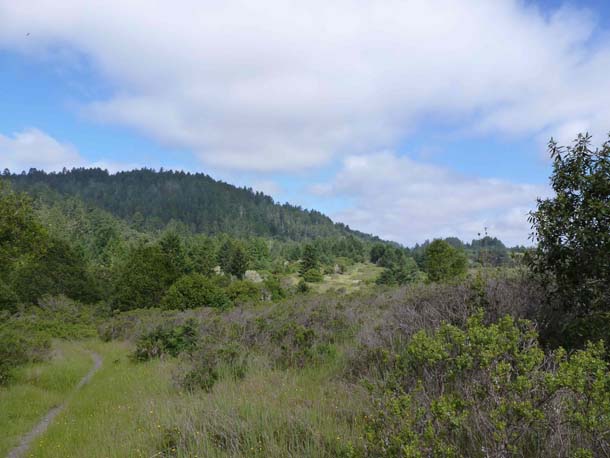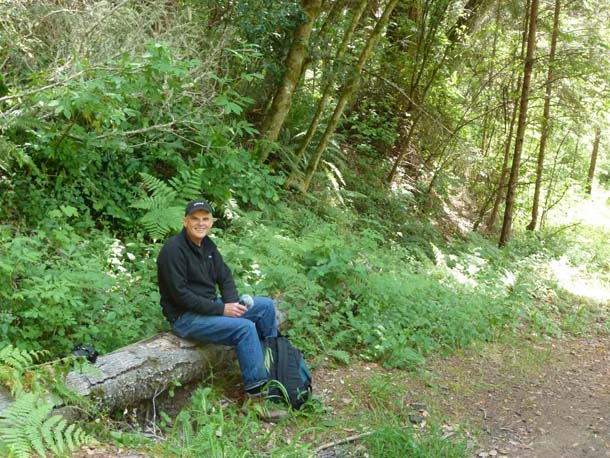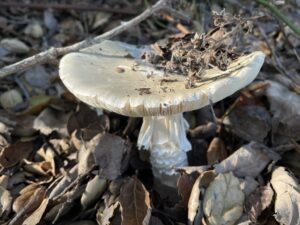Trail notes: Easy, with little elevation change. Two stream crossings necessary when Pine Gulch Creek is flowing.
Check out this and other hikes Jules has taken on this Google map. The most recent hike is in blue; others are in red.
On this trip, I was accompanied by my friend George Clyde, host of the “West Marin Report” of KWMR radio. George put together an excellent audio report of our walk, which is linked here.
One of the challenges of trying to cover every mile of trail on Point Reyes is avoiding double tracking. Not all trails are loops. Some are feeder trails off which other trails branch and these need to be revisited to access the subsidiary trails. The Olema Valley Trail is one of these feeders. I’d already walked the southern and northern sections, but not the middle section of this trail. Notes on the Olema Valley Trail are covered in an earlier posting, “Walking the Rift Zone at Point Reyes.” I covered much of the natural history of the Olema Valley in that earlier report, so only a few incidentals are mentioned here.
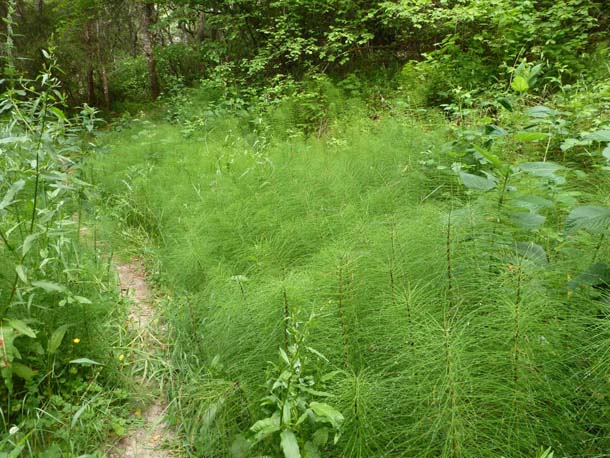
-
Horsetail (Equisetum) and stinging nettle (Urtica) grow side-by-side along the Olema Trail, in full growth by mid-May.
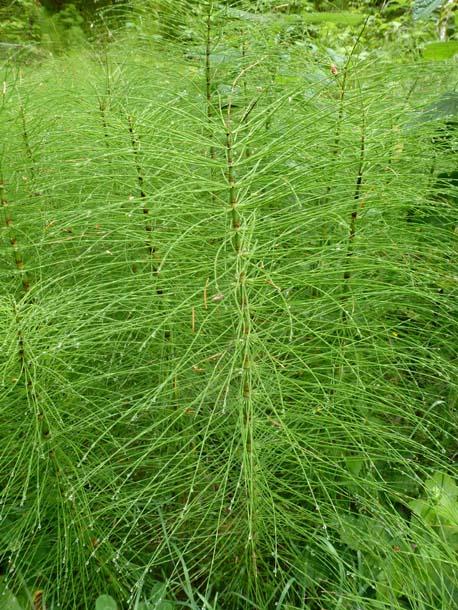
-
Equisetum spreads from underground rhizomes that need moist ground year-round. The stems are fairly rigid and hollow with bamboo-like segments along the length. Each node of the stem carries a whorl of needle-like “leaves,” but photosynthesis takes place in the stems. Photo by Jules Evens.
In its moist, shaded sections, the trail is often bordered by dense growth of herbaceous vegetation. Stinging nettle gets quite tall here, tall enough to rub against one’s forearm or other exposed skin. The result is an unpleasant burning sensation followed by a mild rash. Although it feels as if you’ve been stuck with tiny thorns, the irritation is cause by an acidic chemical exuded from the underside of the leaves. While only a minor irritation, not nearly as pernicious as poison oak, it can be, well . . . nettlesome. Fortunately, a remedy is usually close at hand because horsetail often grows nearby. To neutralize the stinging sensation, simply break off some of the stem of the horsetail, slice it open with your fingernail, and use the moist inner membrane, which contains silicon, as a poultice against the nettle.
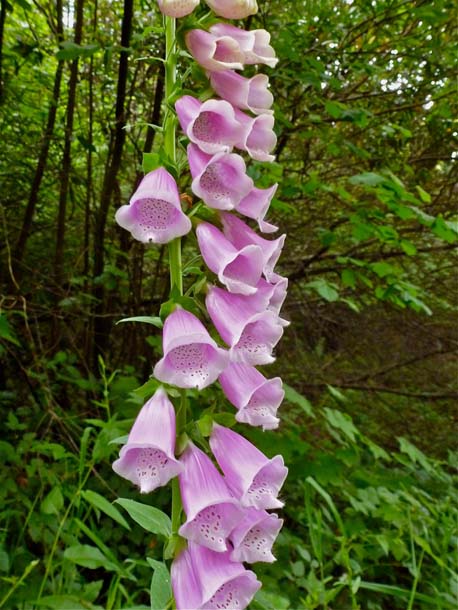
-
Foxglove (Digitalis purpurea), though a medicinal plant used for heart conditions in humans, is highly toxic to mammals and can cause death if eaten. Photo by Jules Evens.
Horsetail is also called “scouring rush” because of its usefulness in washing pots and pans or polishing metal. However, this primitive plant–a living relic from the Carboniferous–is not a rush but is instead closely allied to the ferns. Like ferns, it is a non-flowering vascular plant that reproduces by spores rather than seeds. The spores are borne on long, cone-like structures (strobili) at the tip of some stems.
Although it is already getting late in the flowering season, a few showy blooms are still evident. Foxgloves (Digitalis), a European plant that has become naturalized in the wild here, borders the trail in several shady sections. The tall inflorescences of foxgloves, growing from a basal rosette of leaves, are remarkably attractive. Although nonnative, this is not an invasive plant, but rather unassertive, keeping to itself, never too abundant.
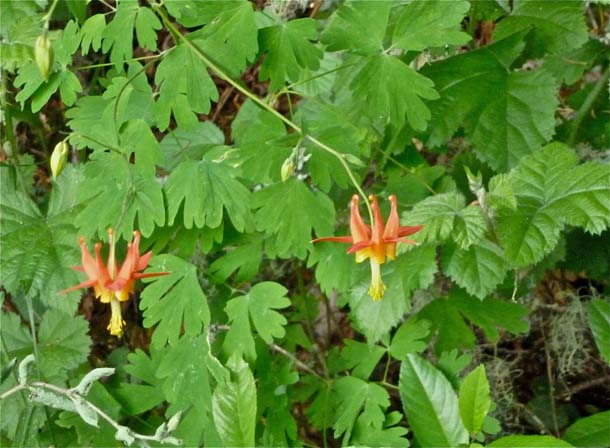
-
Columbine (Aquilegia formosa) is never common on the peninsula, but always a welcome sight. The Latin genus, Aquilegia, may refer to the plant’s affinity for water (water gatherer), or some references say the petal’s shape is similar to an eagle’s spur. Photo by Jules Evens.
Another rather uncommon beauty here, blooming in late May, is the red columbine. It is a native, but also somewhat toxic.
Acknowledgments: Thanks to Doreen Smith who confirmed the identification of the Triteleia (which superficially resembles Brodiaea) and to George Clyde for good companionship and sharing delicious salmon sliders, prepared by Kim LaBou.
Critter List: from now on, I’ll only add species that have not been listed previously. That said, the most common songsters heard on this hike at this time of year were Swainson’s thrush and Wilson’s warbler.
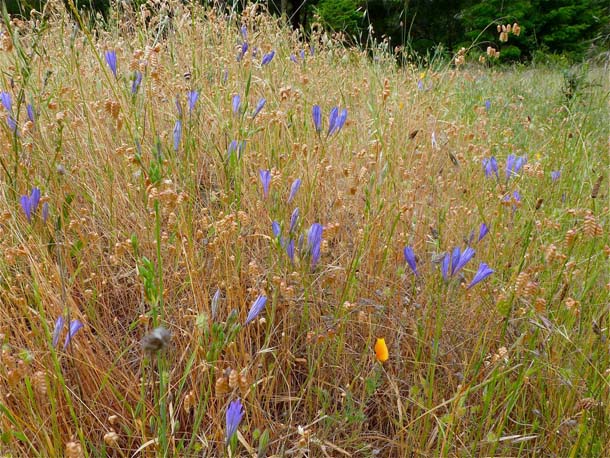
-
“Ithuriel’s spear” (Triteleia laxa), a native wildflower, and non-native rattlesnake grass (Briza) growing in a grassy opening in the forest along the Olema Valley Trail. The genus name Triteleia means “perfect three” in Greek, referring to the 3-lobed stigma and a 3-chambered ovary. Photo by Jules Evens.

